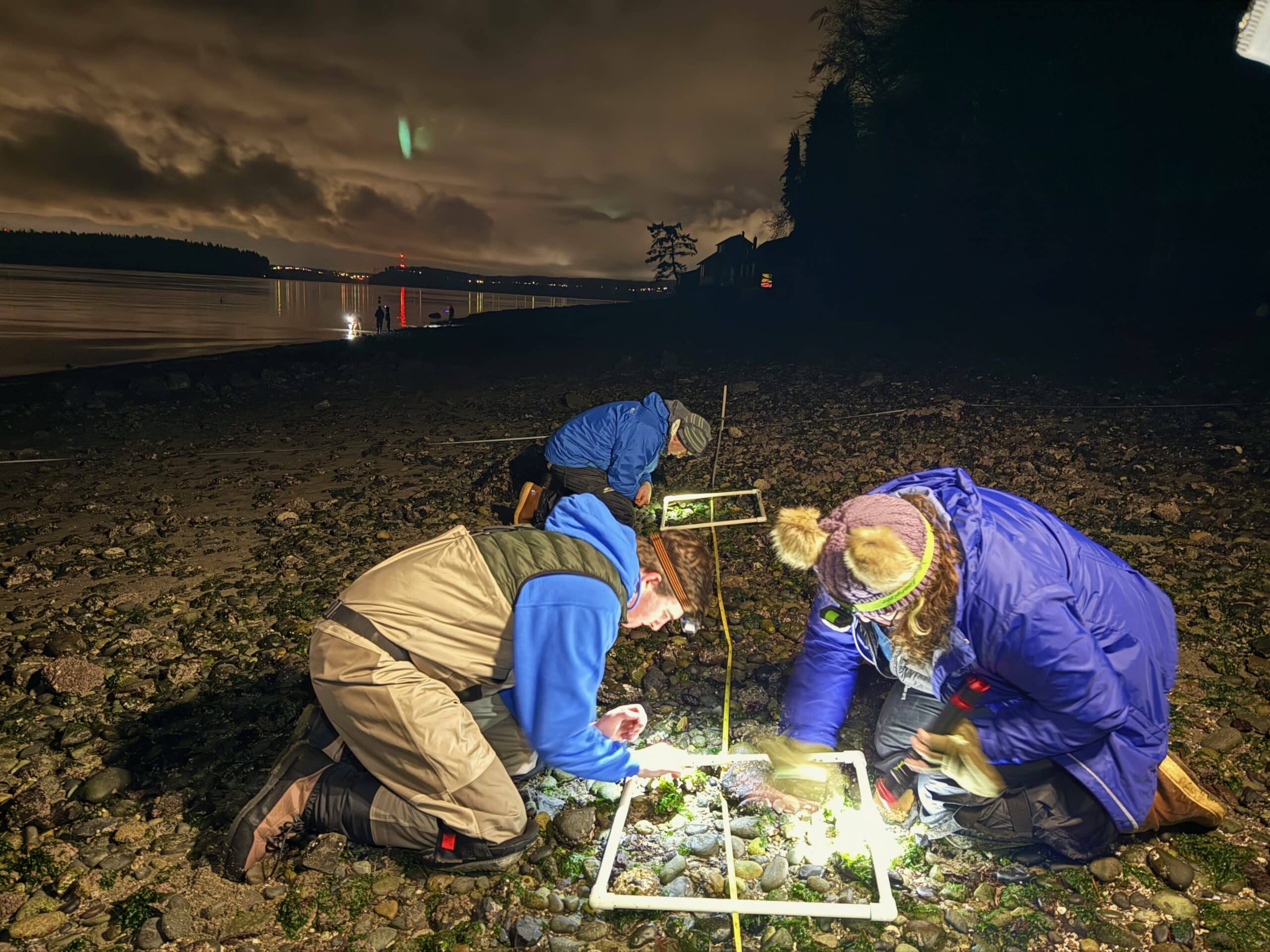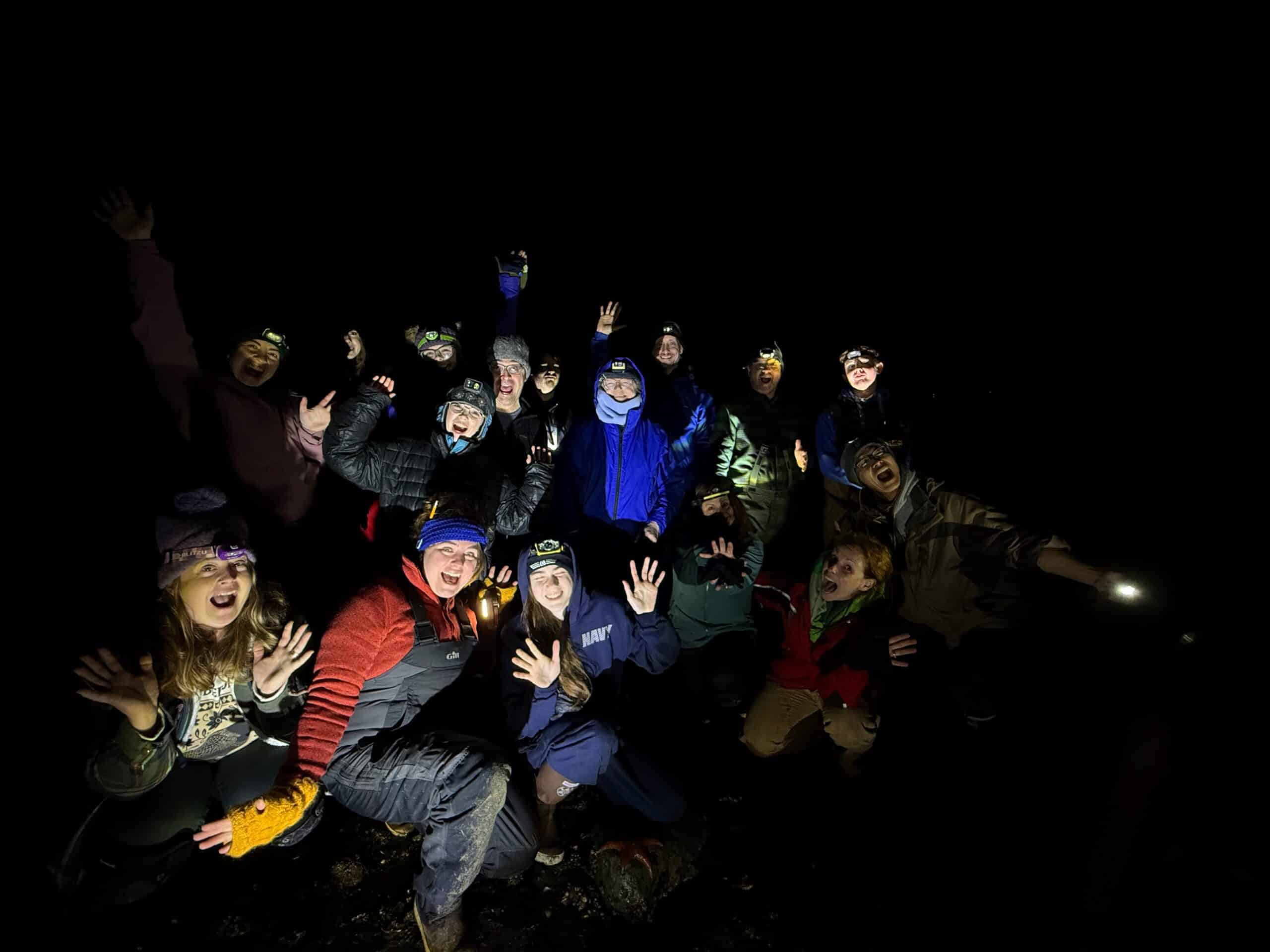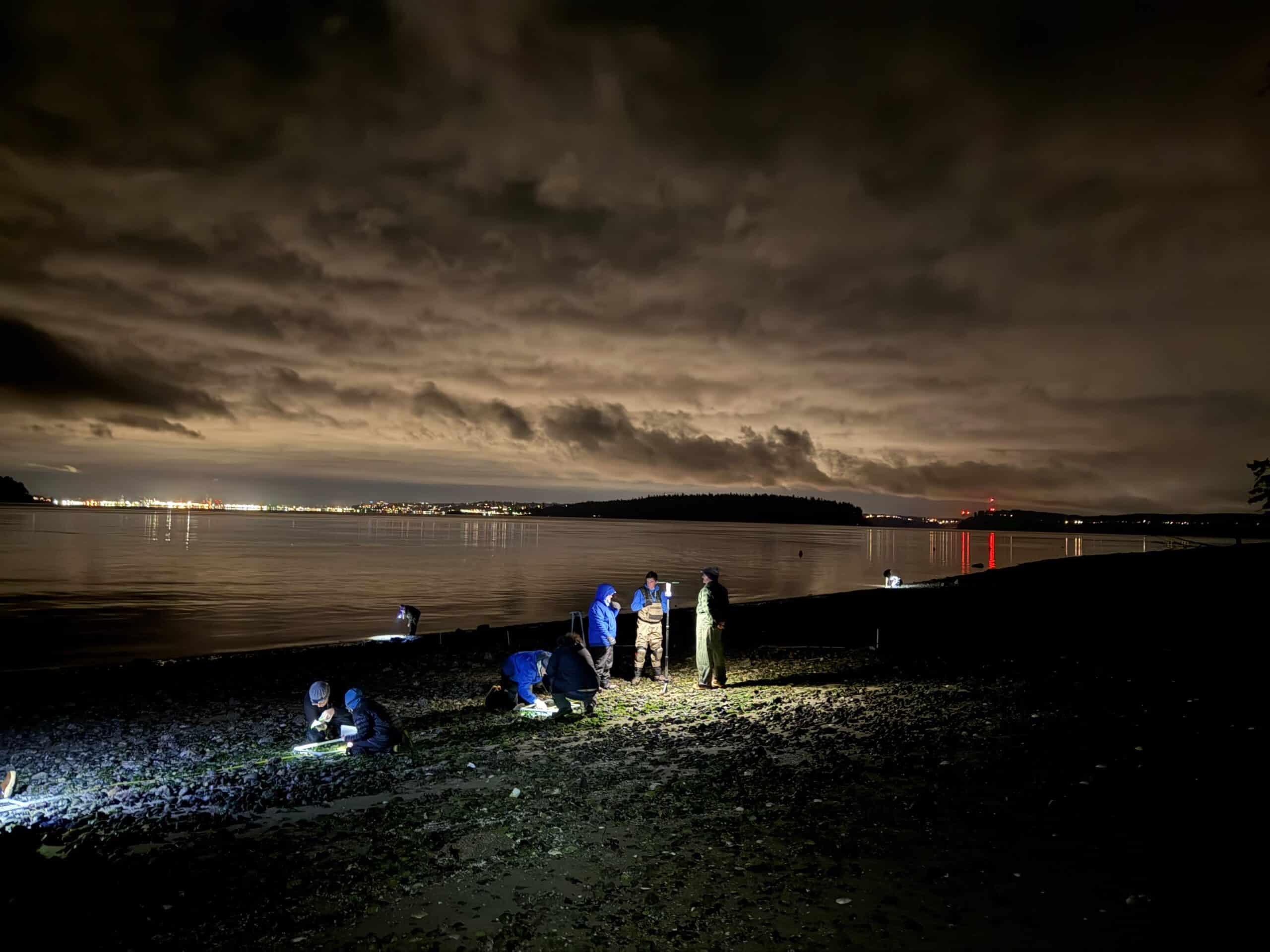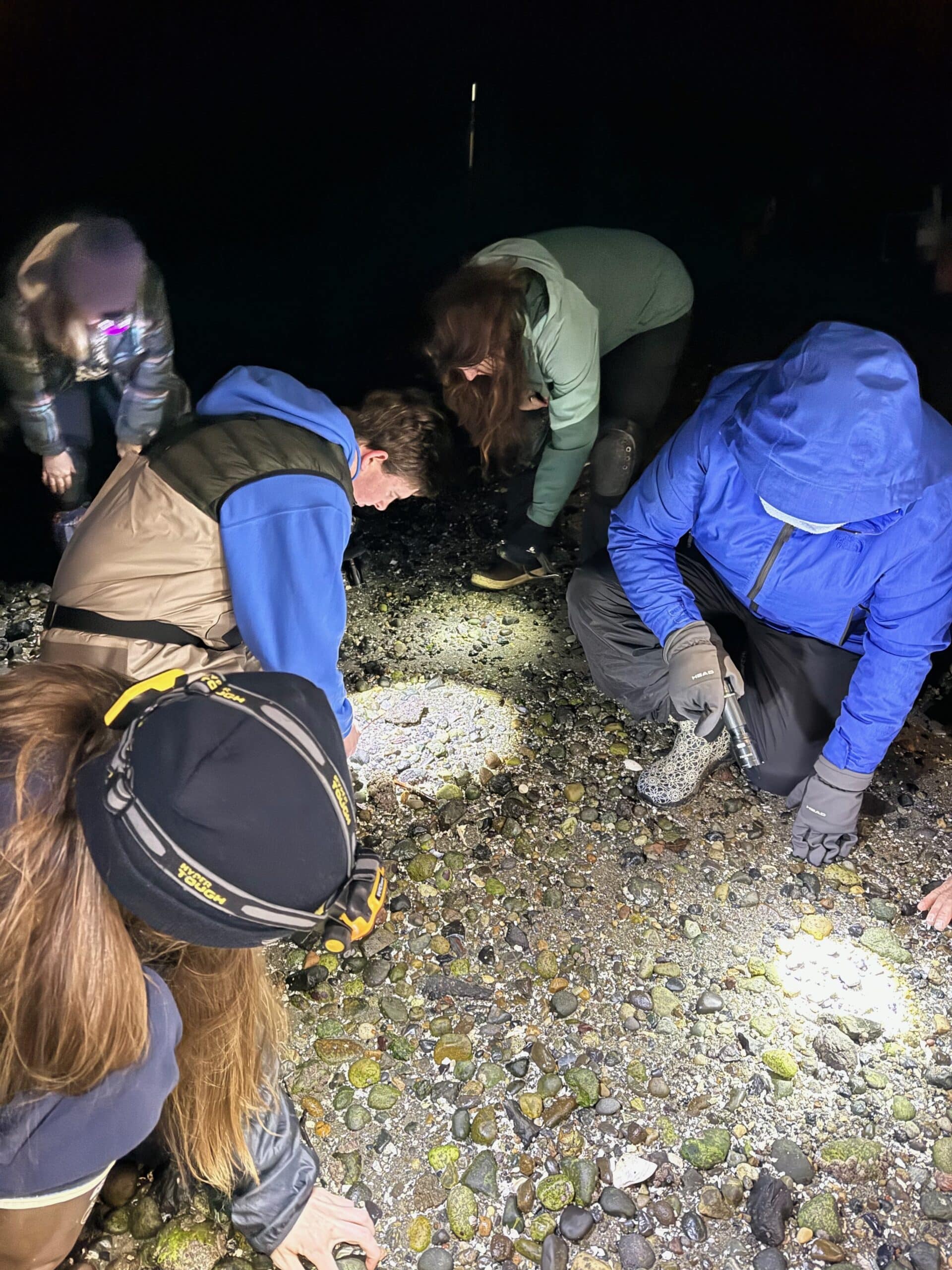Community Environment
Harbor WildWatch’s Beach Monitoring Program keeps volunteers up late
It’s relatively rare to trek the cold, windy beaches of the Peninsula at night, laying down squares of PVC pipe and counting glistening flatworms, tiny snails, snaking strands of eelgrass, and any number of other delightfully interesting marine creatures.
But that’s what a group of folks do several times throughout the early winter, helping Harbor WildWatch gather important biodiversity data as part of its Beach Monitoring Program.
Headed by Harbor WildWatch’s Stena Troyer in partnership with Pacific Lutheran University’s Dr. Michael Behrens, the program is a participatory science endeavor modeled off the Beach Watchers Program at the Snohomish Extension of Washington State University (WSU). The “participatory science” part of this program means that everyone can join, from the littlest elementary school kid to a 90-something retiree looking to shake up their evening.
“We’re measuring the slope of the beach — so how does the slope change? We’re looking at the presence and absence of creatures or evidence of creatures from the top of the beach down to the waterline,” Troyer said. “And then we’re doing quadrat counts, [which is] a way to estimate the populations of sea creatures at different tidal heights.”

Volunteers working during a Beach Monitoring Program for Harbor WildWatch count critters inside a quadrat. They use PVC pipe to form the quadrat, a quarter-meter square. Photo courtesy of Harbor WildWatch
Working at low tide
A quadrat count, Troyer explained, is a quarter-meter square of PVC pipe that allows the group to count the number of creatures in a certain area.
The group uses five quarter-meter quadrats along different tidal heights to count the marine life in the area, which allows them to estimate specific populations. A tidal height is an area of beach exposed at a certain time, when the water is at a certain level. Collecting data during the lowest tide allows the group to record population measurements at several different heights.
“This data really shows how there are different ‘neighborhoods’ across the beach,” Troyer said. “The sea life we count in the higher tide zone is often pretty different from the sea life we will find in the lower zones.”
Troyer explained that soft-bodied animals, like sea stars, will be found closer to the water and tend to be exposed at the lowest tide. Barnacles, on the other hand, “are adapted to survive a lot longer out of the water and can be found across a larger set of elevations on the beach.”
The group goes to the same parts of certain beaches twice a year, during the winter and during the summer, Troyer said. Only at extremely low tide are certain animals and plants exposed enough for observation and counting — and those low, low tides only occur late at night in the winter. This means that the group will often stay out until 11 p.m. or later to collect data.

Harbor WildWatch volunteers during a late-night Beach Monitoring Program session. Photo courtesy of Harbor WildWatch
Working the night shift
For instance, 20 people participated in the Dec. 30, 2024, nighttime expedition to Sunrise Beach Park. All of them stayed out past midnight. But the group’s late-hour efforts were rewarded with some very good news.
“We got to count two sea stars in our quadrats, which is an exciting number, because we also look at sea star wasting syndrome,” Troyer said, referencing the disease that has devastated more than 20 sea star, or starfish, populations up and down the West Coast beginning in 2013.
Troyer said Harbor WildWatch does what’s known as a “timed survey” for sea stars. Such surveys are used to quantify effort expended on a certain task — in this case, looking for sea stars. The group measures both mottled sea stars and ochre sea stars.
“Looking for 15 minutes and finding 100 sea stars is different than looking for an hour and finding the same number,” Troyer said. “So, for sea star wasting surveys, we have a set number of people go out for a set time. During the height of seastar wasting we would often find zero healthy stars during our timed survey and now we’re finding well over 50 stars in that time.”

Beach Monitoring Program volunteers work at Sunrise Beach Park, with the lights of Tacoma in the background. Photo courtesy of Harbor WildWatch
Star of the night
The night of Dec. 30, the group counted a big, healthy adult mottled sea star, and what Troyer described as “a little guy” (a baby sea star) in their squares. The presence of another generation of sea stars indicates the population may be recovering.
“We definitely had a couple of years where we were seeing no sea stars on the beaches,” Troyer said. “The mottled star was one that disappeared for a while. [It was] good to see that next generation of stars coming into play, so we’re like, ‘Yay! That’s cool data to be seeing.’”
The sea star data Harbor WildWatch collects goes to the University of California-Santa Cruz, which aggregates sea star population data from many West Coast organizations. Thanks to this effort, UC Santa Cruz was able to get the sunflower star — one of the species of sea star hardest-hit by sea star wasting disease — listed as “threatened” on the IUCN Red List, Troyer said. But without the participatory science aspect, there would have been neither the people power nor the infrastructure to get the data necessary to do this or to raise the alarm.
“When sea star wasting first hit,” Troyer recalled, “it was these community reports that were really helpful in documenting the spread of the disease and the impact of the disease. And so we’re just maintaining the story of data.”
One specific story the data tells is the continued depletion of the sunflower star from West Coast beaches, Troyer said. Seeing a sunflower star is a rare occurrence indeed. Troyer herself has never seen one, but said that a friend recently sent her a picture of a “dinner plate-sized” sunflower star from Titlow Beach Park.
Hoping not to find these critters
Of course, there are also species the group does not want to see, like the notoriously destructive European green crab, an invasive species that has been making its way up and down the Pacific Coast. The crab’s particular characteristics make it able to out-compete native species for food and living space.
“If we were to detect European green crab at our locations, we want the people in charge to know about it as soon as possible so they can take action to maybe prevent that spread,” Troyer said.
Troyer leads green crab trainings, wherein she teaches participants to keep an eye out for molted green crab shells on beaches. These trainings are slated to resume this year, but no firm date has yet been set.
Up past bedtime
One of Troyer’s favorite things about the program is how in-tune it gets people with the natural world.
“I think one of the cool things that people learn is like, ‘Wow! There are, like, different neighborhoods along the beach from the top of the beach down to the waterline,’” Troyer said, referring to the different tidal heights the groups measure. “We don’t need scuba gear to do these surveys.”
And these nighttime outings also allow potential marine or environmental scientists to get involved at an early age — and, sometimes, surprise the adults. A young girl named Maya, whom Troyer characterized as “hardcore,” was among the monitoring participants on Dec. 30.
“I’m not sure how old Maya is,” Troyer said of that group’s youngest participatory scientist. “But she’s like, ‘I’m way past my bedtime. It’s like striking midnight.’ And I’m like, “Oh, my gosh, kid. You’re hardcore!”

Beach Monitoring Program volunteers look for critters at Sunrise Beach Park in December. Photo courtesy of Harbor WildWatch

